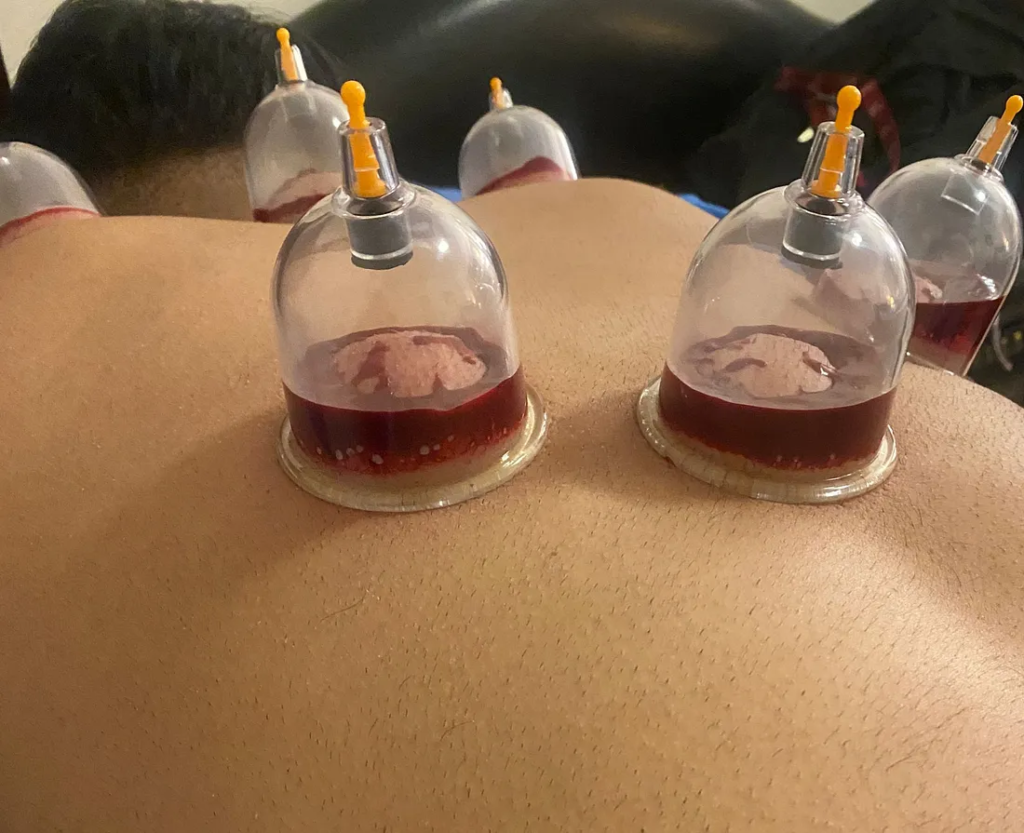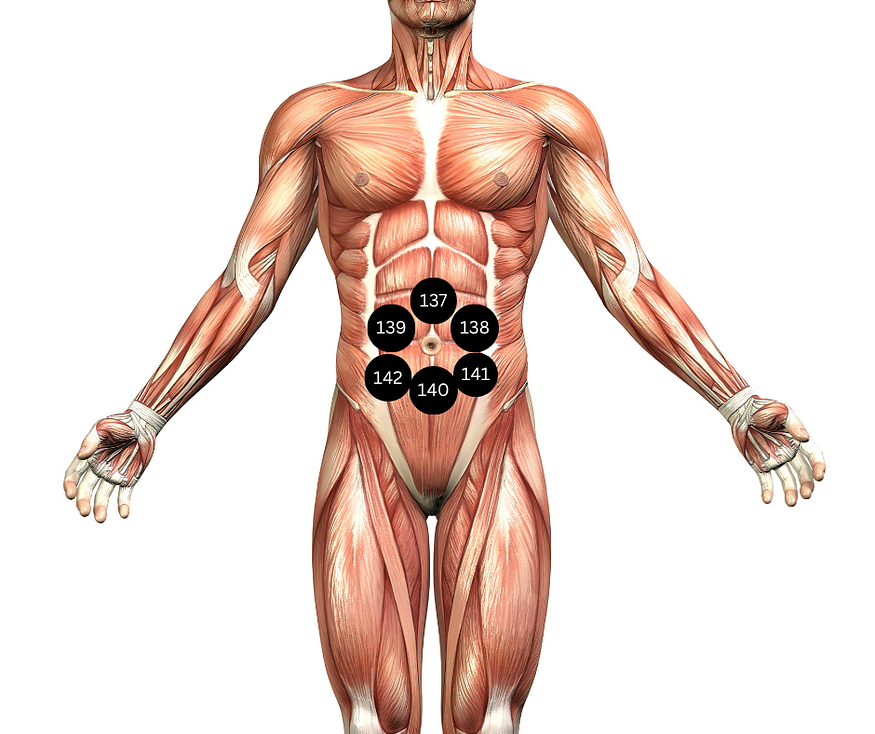No products in the cart.
Benefits of Abdominal Hijama points no 137, 138, 139, 140, 141, 142
Abdominal Hijama points are popular for addressing digestive health issues and various other ailments.

Hijama, also known as wet cupping therapy, is a traditional healing practice that involves applying suction to the skin using cups to draw blood to the surface. It has been used for thousands of years in various cultures, including ancient Egyptian, Chinese, and Middle Eastern medicine.
Hijama points 137, 138, 139, 140, 141, and 142 are located in the abdominal area around the umbilicus (belly button).
Hijama point no 137 is located above the umbilicus (belly button).
Hijama point no 138 is located on the right side of the umbilicus.
Hijama point no 139 is located on the left side of the umbilicus.
Hijama point no 140 is located under the umbilicus.
Hijama point number 141 is located on the right side of point 140, exactly under point 138.
Hijama point number 142 is located on the left side of point 140, exactly under point 139.

Benefits of hijama points 137 to 142
Let’s discuss the benefits of these abdominal hijama points.
1. Digestive Health
When Hijama cupping therapy is performed on these specific body areas, it stimulates the digestive organs, as these points are located directly on the digestive system. When a cup is applied to the stomach area, it enhances digestion by stimulating the digestive organs, including the stomach, intestines, liver, and pancreas. It helps with conditions such as:
- Bloating: When a body feels congested and bloated, Hijama cupping therapy may release congestion and stagnation. Hijama helps alleviate digestive issues by increasing blood flow, enhancing lymphatic drainage, and stimulating the natural healing process. Cupping therapy sucks out the stagnated blood, internal heat and several gases that reduces bloating.
- Indigestion: Cupping therapy promotes contractions that drive food through the digestive tract, aids in removing colon obstructions, promotes the movement of blood and body fluids through organs, and relieves indigestion. Cupping stimulates the parasympathetic nervous system, increasing blood flow to the digestive tract.
- Constipation: During the process of Hijama cupping therapy, the suction inside the cups reaches the soft tissues, muscles, ligaments and lifts the tissues. The tissues are loaded with fresh blood, oxygen and nutrients. When blood circulates through the tissues, it stimulates the healing process, relieves inflammation, and removes dead blood cells and toxins. In a nutshell, it aids constipation.
- Irritable Bowel Syndrome (IBS): Hijama cupping therapy cleanses and detoxifies blood and eliminates heavy metals. IBS is a chronic health condition caused by the hypersensitivity of the digestive system, such as food digesting very slowly or rapidly in the intestines. These abdominal area Hijama points strengthen the digestive system and reduce inflammation.
- Diarrhea: Hijama can help regulate bowel movements and may target the causes of diarrhea. When stagnant blood is removed with hijama, it improves digestive functions and addresses imbalances that may contribute to diarrhea.
2. More Blood Circulation to Digestive Organs
Hijama increases blood circulation and treats a large number of health issues related to the digestive organs.
As dry cupping is applied, it stretches the lymphatic vessels and relieves the localized congestion, also supplying oxygen and nutrients to the cells.
Wet cupping helps to unclog and remove the cellular waste, dead blood cells, uric acid, metabolic waste and toxic waste from the inflamed area.
Hijama affects the composition of blood by thinning it and regulating the red and white blood cells, and also changes acidic blood to neutral blood by balancing the PH levels. Hijama influences the formation of blood as it increases red and white blood cells and changes acidic blood into alkaline blood by purifying the blood.
3. Reduces Inflammation in the Gut
When the suction is applied to the abdominal area through cups, it reduces inflammation. The suction causes micro-trauma to the targeted areas and releases an array of chemicals, fibroblasts and white blood cells to boost the healing process. Our immune system creates inflammation to protect our body from infections. Sometimes with autoimmune diseases like certain types of arthritis, inflammatory bowel disease and multiple sclerosis, our immune system attacks healthy cells. Hijama cupping therapy strengthens the body’s resistance and eliminates pathogenic factors to prevent illness in the gut.
4. Abdominal pain
Cupping therapy on abdominal points can help relieve abdominal cramps, lower back pain, and intestinal inflammation through a combination of local physiological effects and nervous system modulation. The suction caused by cupping draws the blood to the underlying tissues, and the fresh blood flow reduces pain and inflammation by delivering nutrients and oxygen to the tissues.
5. Food Allergies/ Sensitivities
Hijama cupping therapy can be a supportive tool in managing food sensitivities, not by directly eliminating the sensitivity, but by improving gut health, reducing inflammation, and supporting detox pathways. A food allergy will cause some reaction every time the person interacts with the trigger food. The reaction occurs when our immune system overreacts to a food or food particle, observing it as a danger and triggering a defensive response. To protect our bodies from such allergens, nature has developed a perfect mechanism, the immune system. The gut is home to over 70% of the body’s immune system. By stimulating detox organs and reducing systemic inflammation, Hijama may help modulate the immune response to food allergies. Many food sensitivities stem from leaky gut, allowing partially digested food particles to escape into the bloodstream. Hijama may help by enhancing blood flow to the gut lining, supporting the repair of epithelial tissue and removing stagnant blood and toxins that disrupt gut integrity.
6. Supports Liver Function
The liver is our largest internal organ and is responsible for crucial functions like filtering harmful chemicals from food, removing toxins from the bloodstream and storing energy.
Cupping therapy helps to remove the impurities from the blood, and suction increases blood flow in the tissues and organs, specifically in the liver tissues, and the liver cells get activated. This activation helps the liver to perform all its functions properly and efficiently. These abdominal Hijama points correspond with liver reflex zones.
7. Hormonal Regulation In Women
Abdominal cupping may support hormonal regulation, especially in women. It can be beneficial for:
- Irregular menstruation: Hormonal imbalances are one of the most common factors for menstrual irregularities. Hijama has been proven to assist the endocrine system in maintaining balanced estrogen and progesterone levels in the body.
- PCOS (Polycystic Ovary Syndrome): The success rate of the treatment of PCOS through Hijama cupping therapy is very high. In PCOS, ovaries do not develop, so ovulation does not occur properly. Ovulation is directly linked to a woman’s menstrual cycle. Cupping therapy induces ovulation. It also helps to remove blockages and inflammation of the fallopian tubes.
- Menstrual cramps: Hijama cupping therapy promotes the flow of healthy blood throughout the body. Healthy blood flow helps decrease heavy periods and alleviate painful menstrual cramps.
- PMS symptoms: Cupping can help relax tense muscles, which may be beneficial for managing physical discomfort during PMS. Traditional Chinese Medicine views cupping as a way to disperse Qi stagnation, a concept related to blocked energy flow that may contribute to PMS symptoms like pain and tension.
8. Relief For Hemmorrhoid
Cupping therapy may offer relief for hemorrhoids, as it’s believed to help reduce venous congestion in the anal area, which can contribute to hemorrhoid development. Cupping also helps to reduce the pain and itching associated with hemorrhoids.
9. Kidney Diseases
Our kidneys eliminate wastes from the body, regulate body temperature, and pressure of blood, and control the levels of electrolytes in our body. Kidney damage can have a severe impact on the human body. The location of these hijama points is closer to the kidneys, so applying Hijama on the abdominal points may aid in repairing damaged kidneys.
10. Urinary Incontinence
Urinary incontinence is a problem with bladder and sphincter control. It is the uncontrolled leaking of urine, loss of bladder control, often leading to uncontrollable pee leakage. It’s more common in females and people over 50. Performing cupping therapy on these points may help improve bladder control.
11. Infertility Issues
When regular Hijama cupping therapy is performed in the abdominal area to address infertility issues, it improves blood circulation, removes stagnant blood, and allows the body to supply fresh, oxygenated blood throughout the entire body, which helps to facilitate conception. Hijama invokes ovulation by implanting the eggs. It helps to manage imbalanced hormones and also regulates the menstrual cycle.
12. Male Impotence (Prostate and erectile dysfunction)
In males, the prostate gland is essential for normal reproduction because it is required for the survival of sperm as they travel through the female reproductive tract to reach an egg for possible fertilization. Erectile dysfunction (ED) is an inability to sustain a proper erection required to fulfill sexual needs. Performing hijama on these abdominal points may help with male impotence.




Leave a Reply